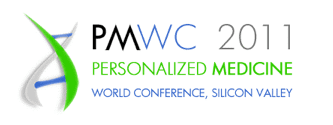
More than 800 people packed the auditorium in Silicon Valley’s Computer History Museum for two days this week listening to the impassioned words of the greatest thinkers, movers, and shakers in personalized medicine. It’s a topic that’s easy to get behind — who doesn’t think that medical care tailored to the individual will result in better care for that individual? — but it’s been a long, hard road, and not for lack of effort. Making personalized medicine the standard of care will require investment and cooperation from healthcare providers, technology innovators, researchers, policy makers, regulatory agencies, entrepreneurs — and each of us, healthy and otherwise. The 2011 Personalized Medicine World Conference certainly played its part, bringing people together from all of these areas for important, eye-opening discussions.
From sessions covering cancer, new business models, regulatory issues, and personal wellness to expert panels looking broadly towards the future of personalized medicine, the conference had a little something for everyone. Some common threads emerged, however: the falling cost of sequencing and other technologies, the rising need for interpretation and tools, and the unsettling disconnect between resources spent on healthcare (or innovation) in the U.S. and treatment outcomes. The vision for personalized medicine is, as Ralph Snyder of Duke University explained in his opening keynote, “science serving humanity, one person at a time,” but we’re not quite there yet. Randy Scott of Genomic Health put the inefficiency of current healthcare systems in stark relief when he said, “we spend billions of dollars every year treating diseases we don’t understand — poorly.”
Mara Aspinall, CEO of On-Q-ity, laid down another heavy statistic: drugs work only 50% of the time, and for cancer they only work 22% of the time. This waste has a dollar cost, she continued, but more importantly, a human cost. The field has its skeptics, too, but as George Church pointed out, the emerging personalized medicine industry won’t be perfect; rather, it will improve iteratively, just like the first televisions, cars, and computers. Church draws additional parallels between personalized medicine and computers, noting that the computing industry didn’t anticipate the power of personal computing — will personal genomics be similarly underestimated?
Speaking more practically, Kathy Hudson (NIH) put forth the idea of “pilot clinics” that would serve as the testing grounds for new systems and technologies in personalized medicine and pioneer the new standards of care. Lee Hood [http://www.pmwc2011.com/speakers.php#hood], the champion of “P4 medicine” (Predictive, Preventative, Personalized, and Participatory), stressed the need for improved communication, IT infrastructure, and education for both patients and physicians. Attendees also heard arguments for employer-centric as well as payer-centric models of personalized medicine adoption from Vance Vanier, CEO of Navigenics, and Larry Leisure of AccelusHealth Partners.
So after all this, what will be the future of personalized medicine? The most popular panel of the conference posed exactly this question to several giants in the field. Lee Hood painted a future where every individual produces billions of data points over time for the purposes of “wellness” monitoring. George Church took this one step further, saying that everyone would be sequenced (there’s a billion data points right there!) and we’d all have personalized health regimens from birth. For Brook Byers, the future is all about networks, from microscopic biological networks affecting disease to social networks affecting healthcare. And in the 2020 that Kathy Hudson envisions, we will all be participating in research, we will all be excited about it, and we will all know what that research means.
As our very own Anne Wocjicki noted in her talk Tuesday afternoon, only 5% of people have ever participated in a research study or clinical trial, but every single one of us is an interesting data point and a potential contributor to important scientific discoveries. With 23andMe’s commitment to genetic research and our unique participant-driven research platform, we hope you’ll agree that, together, we can make that exciting and not-so-distant future happen.
Many thanks to all of the organizers, sponsors, speakers, exhibitors, and attendees for making PMWC 2011 a great success!
Visit the PMWC 2011 website to see the entire conference program and list of speakers. To read more about the talks and discussions from PMWC 2011, check out this collection of thoughts on Twitter.



